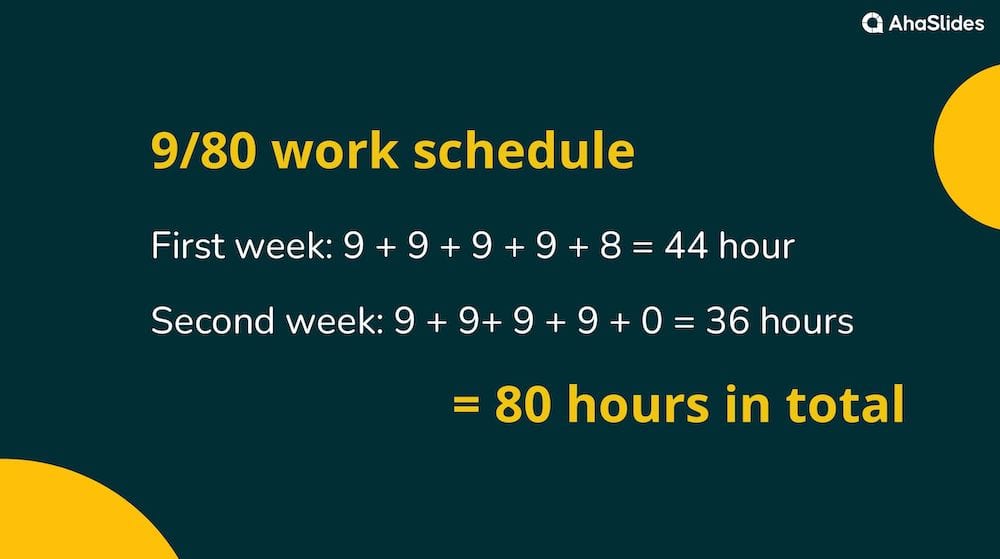Ever feel like the classic 9-5 schedule is just too boring and restricting these days? Well, you're not alone - tons of people think it's time for something new.
More and more companies are realising this, as they're starting to offer alternatives to the normal 9-5 grind.
One option that's gaining popularity is the 80/9 work schedule.
Not sure if it would be a good fit for you or your team? No worries, we'll break it all down for you.
We'll explain exactly how the 9-80 work schedule works, the pros and cons for both employees and employers, and whether it could be a good fit for your business.
Table of Contents
- What is a 9-80 Work Schedule?
- What is an Example of an 80-9 Work Schedule?
- What are the Benefits of a 9-80 Work Schedule?
- Potential Disadvantages of a 9-80 Work Schedule
- Key Takeaways
- Frequently Asked Questions
What is a 9-80 Work Schedule?
A 9/80 work schedule is an alternative to the traditional 9-5, five-day workweek where instead of working 8 hours a day, Monday through Friday, you work 9 hours a day during a two-week work period.
This adds up to 80 hours every two weeks (9 days x 9 hours = 81 hours, minus 1 hour of overtime).
You get every other Friday off as your flex day. So one week you'll work Monday-Thursday and the next Monday-Friday.
This gives you a 3-day weekend every other week, so you effectively get extra time off without using vacation days.
Your schedule is usually set up so your flex day falls on the same day each pay period. This maintains consistency.
Timekeeping still follows the standard 40-hour workweek rules on overtime pay. Anything over 8 hours in a day or 80 hours in a pay period triggers OT.

What is an Example of an 80/9 Work Schedule?
Here's a sample of what the 9/80 work schedule looks like, with a one-hour lunch break each day:
| Week 1 | Week 2 |
| Monday 8:00 – 6:00 Tuesday 8:00 – 6:00 Wednesday 8:00 – 6:00 Thursday 8:00 – 6:00 Friday 8:00 – 5:00 | Monday 8:00 – 6:00 Tuesday 8:00 – 6:00 Wednesday 8:00 – 6:00 Thursday 8:00 – 6:00 Friday Day Off |
Some common industries that utilise the 9-80 work schedule include:
Government offices - Federal, state and local agencies frequently offer 9-80 to employees. Things like DMVs, postal services, and public works departments.
Healthcare - Hospitals want coverage 7 days a week, so the rotating Fridays off help with that. Office staff like clinics and labs also adopt it.
Utilities - Places like water treatment facilities, power companies, etc. need constant monitoring so the schedule improves coverage.
Manufacturing - For 24/7 production floors, 9/80 helps ensure proper staffing across shifts while giving flexibility.
Call centres - Customer service roles work well with the schedule since wait times remain low with staggered weekends.
Law enforcement - Police stations, jails and courthouses adopted it early on to align with operating hours.
Retail - Stores that are open at weekends see it as a retention perk for full-time employees.
Transportation - Anything from airlines to freight companies to the motor vehicles department.
Technology - Startups and tech companies might want to recruit this work schedule to increase flexibility and attract talent.
What are the Benefits of a 9-80 Work Schedule?
Can a 9-80 work schedule be implemented in your company? Consider these benefits to see if it's a good fit:
For the Employees

- Every other Friday off - This bi-weekly schedule gives employees an additional half-day off every other week, essentially providing an extra day off each pay period. This allows for 3-day weekends or a mid-week break.
- Maintains a 40-hour workweek - Employees still work 80 hours over the two-week period, so they don't lose any paid hours. This can help maintain a healthy work-life balance.
- Flexibility - The schedule offers more flexibility than a traditional Mon-Fri schedule. Employees can schedule appointments or handle personal matters on their "off" Fridays without using PTO.
- Reduced commute costs - By getting every other Friday off, employees save on gas and transportation one week out of two. This can lower their monthly expenses.
- Increased productivity - Some studies show a flexible schedule leads to higher job satisfaction and less burnout, which can boost employee engagement and productivity.
- More time for a part-time job - Though we don't recommend it as it can take a toll on one's mental and physical health, the extra day off provides the opportunity for some to take on a side gig or part-time work to earn additional income.
For the Employers

- Increased productivity - Studies show the schedule can reduce stress and burnout, leading to higher quality work. Employees may be more focused and engaged.
- Reduced overhead costs - Offices can be closed every other Friday, saving on utilities, maintenance and other overhead expenses for that half-day each week.
- Attract and retain talent - It gives the company an advantage in recruiting and keeping top performers who value workplace flexibility.
- Improved customer service - Maintaining coverage for extra hours allows for servicing clients or handling appointments/calls throughout the workweek.
- Schedule flexibility - Managers have the flexibility to adequately staff projects or assignments throughout the full working hours of each day.
- Less absenteeism - Employees likely will use fewer sick days or unplanned time off since they have additional scheduled time elsewhere.
- Boost in morale and cooperation - Increased job satisfaction from the schedule leads to better company culture and relations between departments.
Potential Disadvantages of a 9-80 Work Schedule

Before jumping ahead to changing policy, you'll need to consider the flip side of this distinct work schedule, such as:
- Administrative complexity - It requires more coordination and scheduling to ensure adequate coverage across departments every day.
- Potential lack of coverage - There may not be enough staff available on the longer workdays or the "off" Fridays for some roles.
- Overtime costs - Employees working over 8 hours on their scheduled longer days trigger overtime pay requirements.
- Inflexibility - The schedule is rigid and doesn't allow easy switching of days/hours as needs change. May not fit all roles.
- Tracking hours - It's more difficult for managers and payroll to track hours accurately under a non-standard workweek. A structured implementation is important with the timeline for signups and a transition period for coordination/communication.
- Miscommunications - There is an increased risk of miscommunications if staff availability changes biweekly.
- Impacts collaborations - Working different schedules across teams can negatively impact collaboration and group work.
- Inequities - Not all jobs or functions may be suitable for the schedule, creating inequities among roles. Some roles like customer service, healthcare or shift work may not allow schedule flexibility.
- Imbalanced workloads - Work may end up getting unevenly distributed across the biweekly schedule.
- Integration issues - It may be challenging for 9/80 staff to coordinate effectively with partners on a standard M-F schedule.
Key Takeaways
The 9-80 work schedule provides more time off without reducing pay or increasing hours while maintaining a high level of flexibility.
It provides plenty of benefits with proper planning but may not suit all industries or company culture/communication preferences.
Training on schedule specifics like timekeeping, attendance rules and coordination with standard-schedule colleagues is crucial to maintaining a seamless workflow.
Train Effectively Whenever & Wherever You GoNew policies need time to adopt. Communicate your information clearly with engaging polls and Q&A.
Frequently Asked Questions
How many hours is a 9/80 schedule each week?
In a 9/80 work schedule, employees work 9 hours per day over the course of 9 days in a two-week pay period.
What is a 3 12 work schedule?
A 3/12 work schedule refers to a rotation where employees work 12-hour shifts over 3 days per week.
What is a 9 80 schedule in Texas?
A 9/80 schedule works the same way in Texas as it does in other states. Employers in Texas are allowed to implement a 9/80 schedule as a flexible work option for employees, as long as overtime rules are followed.
Is a 9 80 schedule legal in California?
California employers are permitted to use alternative workweek schedules like 9/80 as long as they comply with wage and hour laws. The schedule must be adopted by at least 2/3 vote of affected employees via secret ballot. This legitimises the schedule change.








